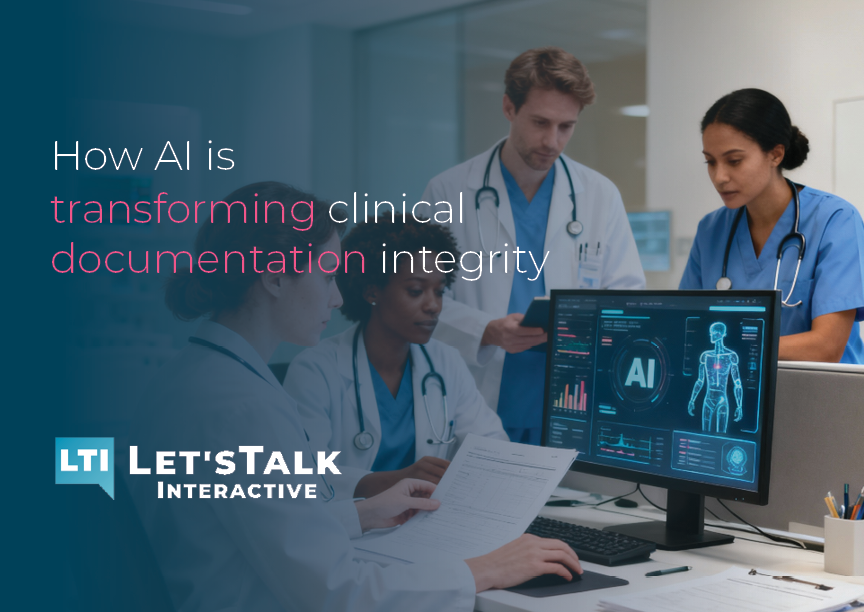How AI Is Transforming Clinical Documentation Integrity: A Game-Changer for Healthcare
Posted: October 23, 2025

How AI Is Transforming Clinical Documentation Integrity: A Game-Changer forHealthcare
By Corrohealth, Adapted for LTI
Clinical documentation integrity (CDI) has long been a cornerstone of healthcare, ensuring patient records are accurate, compliant, and reflective of the care provided. However, the traditional process of chart reviews, provider queries, and coding validation is time-intensive and prone to human error. Enter artificial intelligence (AI)—a transformative force that is revolutionizing CDI by streamlining workflows, improving accuracy, and enhancing financial and clinical outcomes. In this 1200-word exploration, we’ll dive into how AI is reshaping CDI, address common concerns about privacy and trust, and highlight its potential to elevate the role of CDI specialists. This blog is adapted from an insightful article by Corrohealth, whose work has illuminated the path forward for AI in healthcare.
The Evolution of AI in CDI: From Rules to Reasoning
For years, CDI programs relied on natural language processing (NLP), a rule-based technology that excelled at identifying specific terms or extracting structured data from clinical notes. While effective, these systems were limited—they could flag missing elements but lacked the ability to infer or reason. The advent of generative AI has changed the game. Unlike its predecessors, generative AI can synthesize unstructured data, such as lab results, medications, or imaging findings, and produce coherent, actionable outputs.
For example, consider a patient prescribed metformin. Generative AI can recognize that this medication is commonly associated with diabetes, flag the absence of a diabetes diagnosis in the chart, and even draft a compliant provider query to address the gap. More advanced systems, known as agentic AI, take this a step further by autonomously deciding which tasks to prioritize, retrieving relevant evidence from the chart, and providing a clear rationale for their recommendations. This shift from rule-based automation to reasoning-based collaboration marks a significant leap, positioning AI as a true partner in CDI.
Real-World Impact: Efficiency and Financial Gains
The benefits of AI in CDI are already evident in hospitals across the globe. From reducing the burden of manual chart reviews to uncovering missed revenue opportunities, AI is delivering measurable results. Ambient documentation tools, for instance, can transcribe clinician-patient conversations into structured notes in real time, freeing providers from hours of administrative work. Machine learning algorithms guide CDI specialists toward cases with the highest potential impact on reimbursement or compliance, while generative AI uncovers missed diagnoses and suggests precise codes to strengthen documentation.
A compelling case study from a hospital in the southern United States illustrates this impact. By integrating AI-driven chart review into its CDI program, the hospital achieved a fourfold increase in revenue opportunities compared to traditional coder reviews. Reviewers also boosted their productivity, moving from an industry average of 1.5 charts per hour to five or more. These gains are critical for healthcare organizations facing tight margins and increasing regulatory scrutiny.
Navigating Privacy and Compliance Challenges
As AI adoption accelerates, concerns about patient privacy and regulatory compliance have come to the forefront. How can hospitals ensure that sensitive data remains secure? Can AI-generated outputs withstand the scrutiny of auditors? Early adopters have addressed these challenges by implementing robust safeguards. Many run AI models in private, secure cloud environments like Azure or AWS, where protected health information (PHI) is masked before processing. Audit trails, version control, and role-based access controls further enhance accountability.
Equally important is the role of governance. AI recommendations are linked directly to evidence in the clinical chart, ensuring transparency. Confidence scores highlight cases requiring additional human oversight, and clinician-coder teams validate outputs to maintain accuracy and compliance. This multi-layered approach not only satisfies regulatory requirements but also builds trust among clinicians and CDI specialists, paving the way for broader adoption.
The Human Element: Enhancing, Not Replacing, Expertise
Despite its promise, AI’s integration into CDI has sparked concerns among professionals. Will AI render CDI specialists obsolete? Will physicians resent algorithms questioning their documentation? These fears are understandable, but the evidence suggests that AI enhances human expertise rather than replaces it. AI-generated queries and recommendations still require human validation, allowing CDI specialists to focus on higher-value tasks like provider engagement and quality improvement.
Health systems that have successfully adopted AI emphasize the importance of framing it as a tool that eliminates repetitive tasks, not jobs. For instance, AI can automate the tedious process of searching through records, enabling specialists to dedicate more time to strategic initiatives like compliance or denial defense. Sharing early successes—such as faster chart turnaround or reduced denials—helps build enthusiasm and overcome skepticism. Training programs that engage clinicians early are also critical to fostering adoption and ensuring AI complements existing workflows.
Clarifying the Terminology: AI, GenAI, and Automation
One source of confusion in AI conversation is terminology. Terms like “AI,” “generative AI,” and “automation” are often used interchangeably, but they represent distinct capabilities. Automation handles repetitive, rule-based tasks, such as extracting data from forms. Traditional AI, often powered by NLP, identifies structured elements in text. Generative AI goes further by synthesizing information and producing novel outputs, such as drafted queries or suggested diagnoses. Understanding these distinctions helps healthcare leaders set realistic expectations and select the right tools for their needs.
Mitigating Risks: Addressing AI Hallucinations
A significant concern with generative AI is “hallucination”—the tendency to produce plausible but inaccurate outputs. In healthcare, where accuracy is paramount, this risk cannot be ignored. Leading organizations mitigate this by tying AI outputs to verifiable evidence in the patient chart. Confidence scores guide reviewers to focus on high-risk cases, and rigorous model governance ensures outputs align with coding guidelines. By combining AI’s capabilities with human oversight, hospitals can harness its potential while minimizing risks.
Expanding Horizons: AI Beyond Inpatient CDI
While much of the focus on AI in CDI has been on inpatient settings, where diagnosis- related group (DRG) validation and payer scrutiny drive financial stakes, the future lies in outpatient care and risk adjustment models. As value-based care expands, generative AI’s ability to parse longitudinal patient histories, reconcile conflicting notes, and suggest risk-adjusting diagnoses makes it a natural fit for outpatient settings. Some health systems are exploring integrative AI platforms that combine generative reasoning with decision-making logic across domains like utilization management and revenue cycle. This vision of a “clinical intelligence layer” could transform how healthcare organizations operate.
Measuring Success: Outcomes Over Hype
The true value of AI in CDI lies in its outcomes, not its novelty. Key metrics include:
- Throughput Gains: How many additional charts can reviewers process per hour?
- Financial Impact: Are hospitals seeing higher reimbursement and fewer denials?
- Compliance: Do AI outputs align with regulatory standards and withstand audits?
- Clinical Quality: Are comorbidities and patient safety indicators accurately captured?
- User Satisfaction: Do CDI specialists and clinicians find AI tools effective and user-friendly?
By focusing on these tangible measures, healthcare leaders can ensure AI delivers real value.
The Road Ahead: A Collaborative Future
AI is not a replacement for human expertise but a powerful ally in the quest for better clinical documentation. Hospitals that adopt AI thoughtfully—prioritizing transparency, privacy, and clinician engagement—are already seeing improvements in efficiency, reimbursement, and compliance. As AI continues to evolve, its role in outpatient care, risk adjustment, and integrated clinical workflows will only grow. The key to success lies in integrating AI into existing practices, ensuring it enhances rather than disrupts workflows. By doing so, healthcare organizations can achieve records that more accurately reflect patient care, ultimately improving outcomes for both providers and patients. As Corrohealth has eloquently argued, AI is not about replacing people but about empowering them to do their best work. For LTI and the broader healthcare community, the future of CDI is bright—and AI is leading the way.
